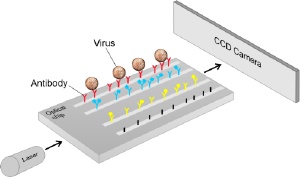May 28 2009
Imagine being able to detect in just a few minutes whether someone is infected with a virus. This has now become a reality, thanks to a new ultra-sensitive detector that has been developed by Ostendum, a spin-off company of the University of Twente. The company has just completed the first prototype and expects to be able to introduce the first version of the detector onto the market in late 2010. Not only does the detector carry out measurements many times faster than do standard techniques, it is also portable, so it can be used anywhere. Ostendum's Aurel Ymeti (R+D director), Alma Dudia (Senior Researcher) and Paul Nederkoorn (CEO) claim that if they had the right antibodies to the swine flu at their disposal, they would be able to highlight the presence of the virus within five minutes. In addition to viruses, the device is also able to pick up bacteria, proteins and DNA molecules.
 Schematic representation of the sensor: light from a laser is directed onto a wave-guide structure (chip) on which several measuring and reference channels are located.
Schematic representation of the sensor: light from a laser is directed onto a wave-guide structure (chip) on which several measuring and reference channels are located.
Following the outbreak of swine flu, the issue of finding a means of detecting quickly and simply whether someone is infected with a virus is again very much on the agenda. It is important to be able to do so as soon as possible in order to prevent the virus from spreading further. However, the techniques that are currently available do not yield results for several hours or even days. Moreover, the tests cannot be carried out without a laboratory or trained personnel.
Researchers at Ostendum, a spin-off company of the University of Twente, have developed a portable device that can show in five minutes whether or not a person is infected with a particular virus. The system is able to detect not only viruses, but also specific bacteria, proteins and DNA molecules, an increased or reduced concentration of which in a person’s saliva may be an indication that they have one illness or another.
The only thing needed by the Ostendum detection method is a sample of saliva, blood or another body fluid from the person being tested and the availability of a specific receptor (i.e. a substance that binds with a specific micro-organism or biological substance). For example, in the case of a virus, a specific antibody served as a receptor on the chip and such antibody to that virus has to be available in order to be able to apply the underlying detection method.
Prototype
Ymeti demonstrated during his doctoral research in 2007 that the principle behind the detector worked. At the time, he used a fairly sizeable laboratory set-up. The Ostendum company was subsequently founded, in 2008, in order to develop the principle into a marketable product.
This week, the company completed the first prototype of the device, and it is presently working on two others. The three prototypes are undergoing practical tests, in a collaboration involving the Laboratorium Microbiologie Twente Achterhoek and the Zwanenberg Food Group. Ostendum will then make further improvements to the design of the device on the basis of the test results, and expects to have the first device ready for introduction to the marketplace in late 2010.
How it works
The device consists of two parts: a lab-on-a-chip-system and a portable detector. A lab-on-a-chip is a miniature laboratory the size of a chip. The chip contains tiny channels that are coated with receptors. The blood or saliva sample is transported to the channels with the help of a fluid system. Substances from the saliva or blood can then bind with the receptors on the chip. Light from a laser is guided through the channels. If any of the substances binds with the receptors in any of the channels, this will alter the phase of the light. Such a change will manifest itself in the interference pattern, and is a fingerprint of any viruses present, for example, or biomarkers. The method is highly sensitive: it is possible to measure the binding of a single virus particle.